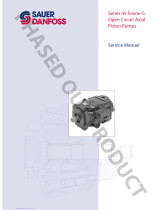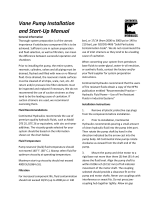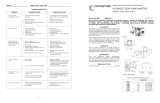
General description
Basic design........................................................................................................................................................................................5
Key features........................................................................................................................................................................................5
Cross sections.................................................................................................................................................................................... 6
System circuit diagram...................................................................................................................................................................7
M46 motor schematic ....................................................................................................................................................................7
Technical Specifications
Overview..............................................................................................................................................................................................8
General.................................................................................................................................................................................................8
Features and options...................................................................................................................................................................... 8
Specifications.....................................................................................................................................................................................8
Operating parameters.................................................................................................................................................................... 8
Fluid specifications.......................................................................................................................................................................... 9
Hydraulic unit life............................................................................................................................................................................. 9
Performance.......................................................................................................................................................................................9
Bearing life and external shaft loading ................................................................................................................................. 10
Operating Parameters
Fluids.................................................................................................................................................................................................. 12
Viscosity.............................................................................................................................................................................................12
Temperature....................................................................................................................................................................................12
Case pressure...................................................................................................................................................................................12
System Pressure..............................................................................................................................................................................13
Speed ratings...................................................................................................................................................................................13
System design parameters
Sizing equations.............................................................................................................................................................................14
Filtration............................................................................................................................................................................................14
Bypass valve.....................................................................................................................................................................................14
Loop flushing valve.......................................................................................................................................................................15
Charge Flow.....................................................................................................................................................................................16
Charge Pressure/Open Circuit Operation............................................................................................................................. 16
Redundant braking system requirement..............................................................................................................................16
Reservoir............................................................................................................................................................................................16
Overpressure protection............................................................................................................................................................. 17
Product coding
Revised model code......................................................................................................................................................................18
Model code modules....................................................................................................................................................................18
Fixed motor.................................................................................................................................................................................18
Variable motor...........................................................................................................................................................................18
Features and options
Anti-Cavitation Valve Option.....................................................................................................................................................20
Displacement limiters...................................................................................................................................................................20
Speed sensor option.....................................................................................................................................................................21
Pulse pickup and connector.......................................................................................................................................................23
Shaft options....................................................................................................................................................................................23
Through-shaft options.................................................................................................................................................................24
Shaft options
M25 MF.............................................................................................................................................................................................. 25
M35/44 MF........................................................................................................................................................................................25
M35/44 MV....................................................................................................................................................................................... 26
M46 MV..............................................................................................................................................................................................27
Control options
Direct displacement control (DDC)......................................................................................................................................... 28
External Control Handle Requirements............................................................................................................................28
Two-position hydraulic control.................................................................................................................................................29
Installation drawings
Technical Information
Series 40 Axial Piston Motors
Contents
©
Danfoss | February 2017 520L0636 | 0703 | 3






















